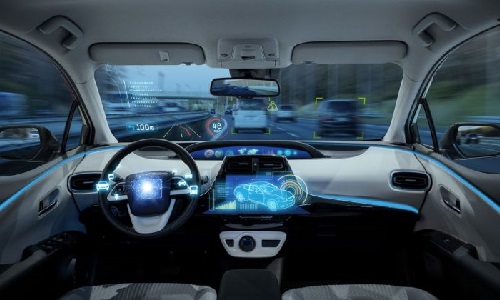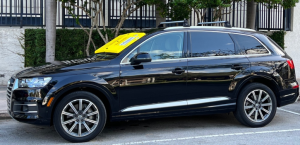By Jeff Sanford
Toronto, Ontario — May 28, 2018 — In this week’s AV Report: the Uber pushback gathers strength, Apple settles for embattled VW, American opinion less supportive of AVs and much, much more!
That automated vehicles could soon share the roads with real drivers is an idea that has evolved from “future dream” to “real possibility” in just a couple years. Just five years ago very few were talking seriously about AVs. Now the world’s first true self-driving car (an Audio) is scheduled to launch in Europe. So far the car manufacturers have had, basically, a free hand to do what they want in terms of introducing what will be the single biggest evolution in the world’s most complex, expensive, consumer item. But that early era of extremely light-touch regulation may be winding down as safety advocates begin to pushback in the wake of the recent Uber collision that killed a pedestrian. Consumer safety advocates will find some solid information on their side in a Wall Street Journal article that ran earlier this week. According to the report, the, “Uber self-driving car involved in a fatal accident in Arizona this spring had determined the need to apply emergency braking a more than a second before impact but wasn’t set up to automatically do so” [italics added]. The National Transportation Safety Board (NTSB) released its report on the March 18 incident. According to the WSJ piece, “The NTSB said the Uber vehicle’s sensors detected the pedestrian walking across the road with a bicycle six seconds before impact. At first, the self-driving system’s software classified the pedestrian as an unknown object, then as a vehicle and finally as a bicycle with varying expectations of where the bike was headed.” The article suggests the self-driving module sent a signal to stop the car 1.3 seconds before impact. According to the NTSB report, that would not have been enough time to stop, but would might lessened the impact by allowing the car to slow from over 40 mph to about 23mph, which would have reduced the severity of the collision. But what’s really amazing in the WSJ article is the idea that the NTSB found that the Volvo’s built-in automatic braking system had been disabled during testing to “reduce the potential for erratic vehicle behavior.” Uber’s decision to deactivate the vehicle’s automatic-braking system and leave it in the hands of the safety operator is a “mistake” according to a source quoted in the article. “This was an absolutely inexcusable design decision,” the source is quoted as saying. Also in the article: “A video released around the time of the crash showed the safety operator glancing down toward the center console of the vehicle several times before impact.” According to the story, In an interview with NTSB investigators, the operator said she, “had been monitoring the self-driving system interface. In addition to being responsible for intervening in the driving of the vehicle, the safety operator is also monitoring diagnostic messages that appear on a digital screen in the center console and tagging events for further review, the NTSB said.” The source in the story is quoted as saying the operator shouldn’t be expected to interact with the screen if it means not looking at the road. “A second Uber employee should have been in the car to interact with the system interface,” said the source. Uber has developed a nasty reputation as a feckless, louche company. This article will reinforce that perception.
Perhaps it was no surprise to hear, later in the week, that Uber had suspended its testing program in Arizona, the state where the collision occurred. According to an article in the tech trade press, “Uber is shutting down testing of self-driving cars in Arizona. In an internal email, [a Uber executive] wrote that Uber would be shifting its focus to Pittsburgh. Uber’s testing program has been grounded nationwide since the March crash that killed a pedestrian.” A Uber exec is quoted as saying, “When we get back on the road, we intend to drive in a much more limited way to test specific use case. Taking this approach will allow us to continually hone the safety aspects of our software and operating procedures. We have also used the past two months to strengthen our simulation capability, which will allow us to be more efficient with our use of road miles.”
On hearing the news that Uber is going to focus its testing program on the city of Pittsburgh the mayor, William Peduto, released a statement saying, “I made it clear to Uber officials after the Arizona crash that a full federal investigation had to be completed, with strong rules for keeping streets safe, before I would agree with the company to begin testing on Pittsburgh streets again.” The conditions are that automated vehicles would never exceed 25 miles-per-hour in the city, on any street, regardless of legal speed limits; the company will have to use its driver app to alert human drivers when they are exceeding speed limits, so human drivers adhere to speed limits as well. The mayor also seemed to take a bit of a shot at Uber. According to the mayor’s press release, “Uber did not tell me of today’s announcement, and I was forced to learn about it through social media reports. This is not the way to rebuild a constructive working relationship with local government, especially when facing a public safety matter.”
Tesla is also experiencing pushback over its automated driving system. Several recent accidents have cast a negative light on a system many think was launched in a rush (and, hence, is a bit unsafe). Elon Musk had promised that one of his cars would drive across North America without a driver by the end of 2017. He no longer mentions that missed promise. It was reported this week that a pair of consumer advocacy groups consider Tesla’s promotional claims about the safety and of its Autopilot driver-assistance technologies are “deceptive and want the U.S. Federal Trade Commission to investigate.” A media report quoted a letter sent to the chairman of the FTC by the Center for Auto Safety and Consumer Watchdog. “Two Americans are dead and one is injured as a result of Tesla deceiving and misleading consumers into believing that the Autopilot feature of its vehicles is safer and more capable than it actually is,” according to the letter.
A new report from AAA reveals that the majority of U.S. drivers will seek autonomous technologies in their next vehicle, but they, “continue to fear the fully self-driving car.” According to the press release, “Despite the prospect that autonomous vehicles will be safer, more efficient and more convenient than their human-driven counterparts, three-quarters of U.S. drivers report feeling afraid to ride in a self-driving car, and only 10 percent report that they’d actually feel safer sharing the roads with driverless vehicles. As automakers press forward in the development of autonomous vehicles, AAA urges the gradual, safe introduction of these technologies to ensure that American drivers are informed, prepared and comfortable with this shift in mobility.” The director of Automotive Engineering and Industry Relations for AAA, Greg Brannon, is quoted as saying, “A great race towards autonomy is underway and companies are vying to introduce the first driverless cars to our roadways while U.S. drivers are eager to buy vehicles equipped with autonomous technology, they continue to fear a fully self-driving vehicle. U.S. drivers may experience the driver assistance technologies in their cars today and feel they don’t work consistently enough to replace a human driver – and they’re correct. While these technologies will continue to improve over time, it’s important that consumers understand that today’s systems require your eyes on the road and your hands on the wheel.”
Audi is about to release what auto analysts are calling the first vehicle with real self-driving capability. But the car will only be released in Europe, as expects suspect the company wants to avoid the headaches that would follow on the emerging regulatory chaos in the United States. According to a media report, “When the 2019 A8 sedan hits dealer lots later this year, Europeans will have access to Traffic Jam Pilot, which will take control of the car on the highway at speeds below 37 mph; no need for the constant human supervision required by current systems like Tesla’s Autopilot. [But] when the A8 goes on sale [in North America], it won’t come with Traffic Jam Pilot. Audi’s bosses don’t want the drama.” The story goes on to note that Audi’s system is a capable one that, “puts more trust in the computer than anything before it. Audi will be the first automaker to launch what engineers call a ‘Level 3’ system, which can safely control itself, but still needs a human available to take over if, say, the weather turns scary or the lane lines disappear. (Drivers using Tesla Autopilot, Cadillac Super Cruise, or Nissan Pro Pilot are told the watch the road at all times and remain ready to take over from one second to the next.) The difference is small but important. As Audi’s website puts it: ‘With Traffic Jam Pilot engaged, drivers no longer need to continuously monitor the vehicle and the road. They must merely stay alert and capable of taking over the task of driving when the system prompts them to do so.’ If you’re on the highway and stuck in slow traffic, activate the system and feel free to look at your phone or even read a book.” This will be a perk only Europeans will enjoy. According to the report, “when it comes to the US market, Audi’s concerns include uncertainty about how federal and state laws apply to this system. Where Germany passed a law last year making this sort of thing explicitly legal, the US federal government hasn’t done much of anything.”
The New York Times ran a major feature on Apple’s shifting strategy around AVs. The story is a fascinating look into the tech giant’s journey into to the auto industry. Turns out a company often considered full of geniuses was intimidated by the complexity involved in building a massive 2,000 object that moves. According to the times Apple once been aiming to design and build its own electric self-driving car. “Over time, the tech giant’s ambitions ran into reality,” according to the Times. “Apple curtailed its original vision, first by focusing on software for self-driving cars and then by working solely on an autonomous shuttle for its own use with employees. Now, the tech giant has settled for an auto partner that was not its first choice.” The Times reports that, “In recent years, Apple sought partnerships with the luxury carmakers BMW and Mercedes-Benz to develop an all-electric self-driving vehicle. But on-again, off-again talks with those companies have ended after each rebuffed Apple’s requirements to hand over control of the data and design. Instead, Apple has signed a deal with Volkswagen to turn some of the carmaker’s new T6 Transporter vans into Apple’s self-driving shuttles for employees – a project that is behind schedule and consuming nearly all of the Apple car team’s attention.” BMW was long Apple’s top choice, “given its focus on high-end but mainstream products.” According to the story, “Many Apple executives, including the company’s chief executive, Timothy D. Cook, also drive BMWs. Mr. Cook visited BMW as early as 2014 to discuss a partnership, and those on-and-off negotiations continued for years. But a person close to the talks said any deal now appeared dead because both Apple and BMW wanted to own the customer experience and relationship. Apple’s other favored choice was Mercedes-Benz. But those negotiations were halted because of similar disagreements over control of the experience and data, said one person close to the talks. Late last year, Apple found that partner in Volkswagen. Buffeted by a scandal around cheating emissions tests – and lagging some rivals in development of self-driving cars – Volkswagen jumped at the chance to work with Apple.”





































